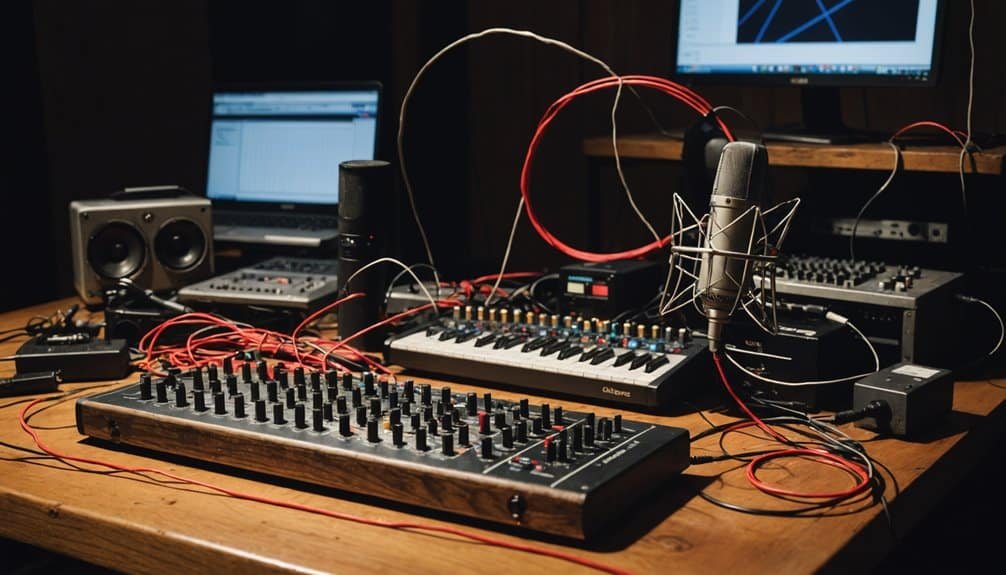Many businesses opt for DIY jingles to save costs, yet this choice often backfires. Poor sound quality and unpolished production can tarnish a brand’s image, alienating customers instead of attracting them. Amateur efforts may fail to convey the intended message, leaving listeners unimpressed or irritated.
Could this be happening with your jingle? Uncover the subtle pitfalls that might be pushing your audience away.
Critical DIY Jingle Pitfalls That Damage Brand PerceptionKey Takeaways
- Poor sound quality in DIY jingles can annoy listeners and harm brand perception.
- Inconsistent branding in jingles can confuse customers and erode trust.
- Uninspired melodies fail to evoke an emotional connection, thereby reducing audience engagement and interest.
- A lack of testing means flaws go unnoticed, weakening the effectiveness of the jingle.
- Repetitive or annoying elements in DIY jingles risk alienating consumers.
Amateur Sound Quality Issues
Starting on a DIY jingle project often reveals the pitfalls of amateur sound quality, a crucial barrier to crafting a professional auditory experience. For those seeking to connect with an audience, poor frequency control can sabotage efforts, as incorrect high-pass filtering thins out tracks below 80Hz, stripping body from vocals and guitars. Overlapping frequencies create muddiness, as clashing elements like bass and kick drums clash.
Equally damaging is improper equalization, where excessive bass enhancements obscure essential midrange details, muddling consumer messaging. Harsh treble peaks induce listener fatigue, pushing audiences away. Additionally, neglecting the full human hearing range, which spans 20 Hz to 20 kHz, can result in missing critical nuances in sound reproduction.
To belong in the creative community, one must strategically address these flaws, ensuring clarity across devices and genres, thereby enhancing their overall impact. Mastering these elements transforms a jingle into a resonant, professional tool for connection, reinforcing brand recognition that enhances emotional engagement with your audience.
Inconsistent Brand Representation
While crafting a DIY jingle can be a creative endeavor, inconsistent brand representation poses a significant threat to establishing a trustworthy and memorable identity. When visuals, tone, or messaging vary across platforms, confusion erodes consumer trust, with 54% of customers abandoning brands that fail to meet consistency expectations. This disjointed approach muddles brand identity, obscuring core values and hindering the sentimental connections crucial for loyalty within a community.
Moreover, inconsistent branding risks a 23% revenue loss compared to unified competitors, as fragmented experiences weaken recognition and recall. For those seeking to belong to a reliable brand family, consistency is key. A cohesive presence across channels builds trust and guarantees a strong, recognizable identity that resonates deeply with audiences.
In fact, consistent branding can require 5 to 7 brand impressions for consumers to remember a brand, reinforcing the importance of uniformity across all touchpoints. Additionally, successful jingles can enhance brand memorability by creating strong emotional connections that foster loyalty.
Negative Emotional Reactions
Beyond the pitfalls of inconsistent brand representation, a more profound concern emerges with adverse affective reactions triggered by poorly crafted DIY jingles. These creations often provoke sentimental dissonance, as irritating melodies or mismatched tempos clash with intended moods, leaving listeners annoyed or confused. Even worse, offensive messaging—through insensitive lyrics or cultural missteps—can shatter trust, alienating communities who crave connection and respect.
A jingle that feels tone-deaf or exploitative risks turning potential allies into critics, undermining the sense of belonging brands aim to foster. Poor production, like off-key vocals or grating sounds, further amplifies discomfort. Strategically, businesses must recognize that such adverse reactions harm their reputation.
Crafting jingles with care guarantees effective resonance, uniting rather than dividing audiences. Background music can enhance product memory and brand recognition, making emotional connections in jingles vital to building trust and loyalty with listeners, ensuring a positive impact (emotional connections).
Declining Audience Engagement
Declining audience engagement poses a critical challenge for DIY jingle creators, as lower listening rates directly undermine the impact of their efforts. Reduced sharing potential further limits reach, as audiences are less inclined to promote content that fails to captivate amidst shrinking attention spans. With internet users spending an average of 143 minutes daily on social media, DIY jingles must compete for attention in a crowded digital space.
To effectively engage listeners, brands should consider utilizing sonic branding strategies that enhance emotional connections and brand recognition, which are vital in an increasingly distracted online environment.
Lower Listening Rates
How can a DIY jingle, crafted with passion, still fail to retain an audience? The answer lies in lower listening rates, a critical sign of declining engagement. Poor production values, such as low-quality recordings with hiss or distortion, create an unpleasant listening environment that repels listeners.
Muffled vocals obscure branding messages, while uninspired melodies and generic chord progressions fail to resonate with audience preferences, leaving no lasting impact. When jingles clash with the intended mood or demographic tastes, they alienate the very community they aim to connect with. Tailoring musical composition to specific demographics can significantly enhance resonance and connection.
Additionally, catchy melodies are essential for improving retention and engagement; without them, the jingle may quickly fade from memory. Without strategic alignment and quality execution, even sincere efforts risk alienating audiences.
Reduced Sharing Potential
 Disconnection looms as a silent threat when DIY jingles fail to inspire sharing among audiences, undermining their potential to amplify brand reach. Without jingle memorability, crafted through catchy hooks or relatable rhythms, listeners find no reason to pass the tune along to their communities. An expressive connection, crucial for sparking joy or nostalgia, is often absent in DIY efforts, leaving the content forgettable and unshared.
Disconnection looms as a silent threat when DIY jingles fail to inspire sharing among audiences, undermining their potential to amplify brand reach. Without jingle memorability, crafted through catchy hooks or relatable rhythms, listeners find no reason to pass the tune along to their communities. An expressive connection, crucial for sparking joy or nostalgia, is often absent in DIY efforts, leaving the content forgettable and unshared.
Strategically, the lack of cultural alignment or consumer testing means these jingles fail to achieve viral success. Without feedback or platform optimization, they fail to resonate within social circles craving shared experiences. For a brand to belong, its jingle must invite connection, not isolation, ensuring it echoes beyond a single listen.
Additionally, professional jingles often possess higher quality production, making them more likely to connect emotionally with audiences and encourage sharing.
Shorter Attention Spans
Frequently, modern audiences exhibit shorter attention spans, posing a significant challenge for DIY jingles attempting to maintain engagement in a crowded online environment. With Gen Z and millennials favoring bite-sized, interactive content, understanding audience preferences is critical to stand out in a community seeking connection. Data shows plummeting engagement rates—Instagram at 0.50%, Facebook at 0.15%—reflecting a shift in content consumption toward quick, immersive formats.
DIY jingles must adapt strategically to this reality. Platforms like TikTok prioritize watch time over likes, rewarding brief, intriguing content. As natural reach declines by over 20%, creators in this shared digital space must craft jingles that hook instantly, aligning with evolving attention patterns to foster a sense of belonging and sustain relevance amidst fierce competition. Audio branding’s emotional impact can also play a crucial role in creating memorable jingles that resonate with consumers.
Absence of Testing and Refinement
While crafting a DIY jingle may seem cost-effective, the absence of thorough testing and refinement often undermines its potential impact. Without structured validation, creators miss crucial audience feedback and the chance for iterative adjustments, leaving flaws unchecked. This disconnect risks alienating the very community one hopes to join.
Crafting a DIY jingle might save costs, but without testing and refinement, its impact falters, risking alienation of your intended audience.
Consider these critical oversights in DIY approaches:
- No Focus Group Insights – Missing poignant resonance cues that bond listeners to brands.
- Insufficient Context Testing – Failing to verify that jingles shine in authentic settings, like in-store play.
- Static Creative Output – Lacking refinement cycles to enhance appeal and memorability.
Strategic testing unites creators with their audience, guaranteeing that jingles resonate deeply. Adopt this process to avoid wasted potential and build lasting connections.
Repetitive and Irritating Elements

As DIY jingles gain traction, a critical pitfall emerges in the form of repetitive and irritating elements that can sabotage brand perception. Overplayed tunes often lead to repetitive messaging fatigue, where audiences become desensitized due to excessive exposure to the same message. Research shows that 72% of consumers dislike such redundancy, craving fresh and engaging content that resonates with their desire to connect.
Moreover, annoying sound patterns can alienate listeners, disrupting sentimental ties to a brand. Inconsistent rhythms or mismatched melodies heighten frustration, making it harder for communities to accept the message. Strategically, brands must strike a balance between repetition and avoidance to prevent irritation while fostering recall.
By crafting jingles with care, companies can unite their audiences, turning potential annoyance into a shared, memorable experience that encourages a sense of belonging.
Frequently Asked Questions
How Can I Legally Use Copyrighted Music in Jingles?
To legally use copyrighted music in jingles, one must obtain proper music licensing and comply with copyright law. Strategically negotiate sync and master licenses, ensuring compliance, to join a community of responsible creators.
What Budget Is Needed for a Professional Jingle?
Understanding professional jingle costs is crucial for strategic branding. This jingle pricing guide reveals that devices typically range from $2,000 to $3,500 for local campaigns. Join savvy marketers by investing wisely for lasting impact.
Can DIY Jingles Work for Small Local Businesses?
For small local businesses, DIY jingles can be successful if crafted with care, thereby enhancing their effectiveness and shaping a positive customer perception. Strategic alignment with community values fosters a sense of belonging, making these efforts resonate deeply with locals.
How Do I Find a Jingle Creation Service?
Amidst a noisy market, silence can deafen a brand, while an enchanting tune unites. To find jingle services, one should investigate creative agencies like Flatworld Solutions, strategically aligning audio branding with community resonance.
Are There Free Tools for Better Jingle Quality?
For superior jingle creation, free tools like Musicful.ai and Suno offer strategic audio editing solutions. Their professional outputs foster brand connection, inviting businesses to join a community of polished, audience-resonant marketing innovators.
Conclusion
 Writing your own DIY jingle with cheap software may seem like a great idea, but it can hurt your business more than help. Bad sound quality and off-key music can annoy people and make your brand seem unprofessional. Even if your message is good, poor sound can cause customers to tune out.
Writing your own DIY jingle with cheap software may seem like a great idea, but it can hurt your business more than help. Bad sound quality and off-key music can annoy people and make your brand seem unprofessional. Even if your message is good, poor sound can cause customers to tune out.
When a DIY jingle doesn’t match your brand or feel catchy, it can confuse your audience. They may not remember your business—or worse, remember it for the wrong reasons. That’s whytesting and editing matter so much in jingle creation.
As a professional jingle writer, I’m here to help you stand out the right way. Let’s create a sound that connects with your audience and builds absolute trust.
Ready to hear the difference? Let’s talk.
References
- https://scoreascore.com/blog/8-reasons-why-jingles-are-powerful-in-advertising/
- https://www.warc.com/newsandopinion/opinion/dont-overlook-the-power-of-the-humble-jingle/en-gb/6290
- https://soundbrandingideas.com/the-magnetic-power-of-advertising-jingles/
- https://healthcaresuccess.com/blog/healthcare-marketing/advertsing-jingles.html
- https://thejinglewriter.com/advertising-jingles/
- https://neelmodi.com/the-not-so-secret-ingredient-to-making-your-mixes-sound-good/
- https://mixingmonster.com/audio-frequency-response/
- https://www.musicradar.com/how-to/fix-an-amatuer-sounding-mix-to-sound-pro
- https://www.youtube.com/watch?v=3mv946xEtxY
- https://mixingmonster.com/best-audio-interfaces-for-music-production/

Cary Reich is a master jingle-writer with over 35 years of experience creating brand‐defining melodic slogans and audio identities. Since 1985, Cary has crafted memorable campaigns for both national and local clients — including Budweiser, Firestone, Gold’s Gym, Goodwill, and YMCA — blending creative vision and musical expertise to make businesses not just heard, but remembered.

